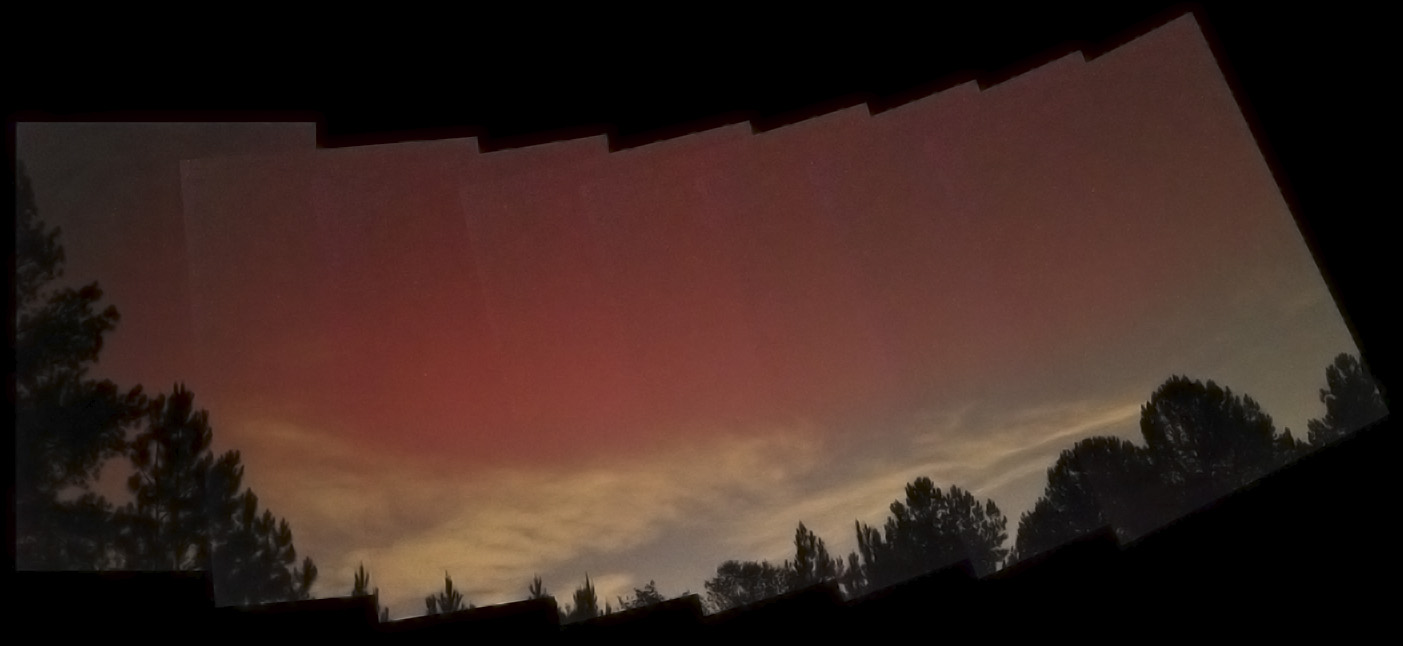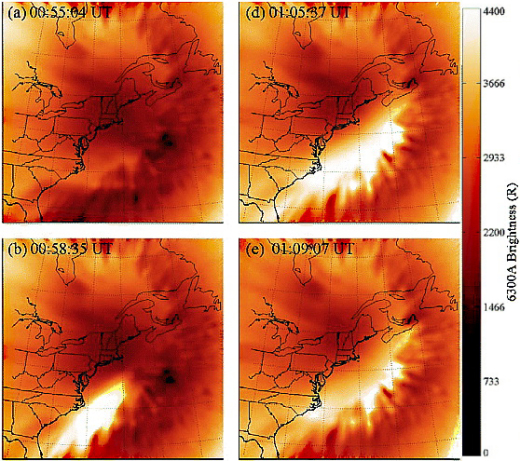| |
The Rocket's Red Glare
06/19/2022. I went out to watch the June 19th midnight launch of a SpaceX Falcon 9. Here in western North Carolina, I was hoping for a faint, moonlit "jellyfish." I found an opening in the pines and waited. But the rocket's trajectory was much higher than I expected (it was almost 500km up by the time it was due east of me, not 150-200km as are most SpaceX flights up the Atlantic coast), and the rocket got by me unseen. A minute or two after its closest approach (by the clock), I noticed this red glow spreading across a broad swath of the eastern sky. This photo shows the extent of the glow about five minutes after the rocket's passage. The lights of Hickory and a little of Charlotte and a maybe a tiny bit of the not-yet-quite-risen Moon light the clouds. That red glow has to be rocket-related, no? But what is it?

Sure, click it. You won't see much more, but go ahead.
8-frame Mosaic: 105mm F1.4 Sigma, ISO 25,600, Canon R6
Yes, I should have brought a wideangle lens along, too.
It looked for all the world like a faint, high-altitude aurora (red, transparent, somewhat variable). The vertical and near vertical stria are artifacts from compositing the mosaic without first flatfielding the component images. This glow was invisible to my eyes under clear, city-lit skies but prominent in the EVF of my camera. I "pushed" the component frames one stop (to an effective ISO of 51,200) when opening them in Adobe Raw and boosted their saturation just a bit. Each panel of the mosaic is pretty well aligned on the stars.
Standing in the shower, it struck me that it probably is a red aurora, one energized by the interaction of the rocket exhaust and ionospheric oxygen. It's the same altitude regime where oxygen glows red when hit by coronal ejecta. Also, in that much thinner environment, the plume which is plainly visible at lower altitudes as a shock front between the exhaust and appreciably denser air ("denser vacuum"?) may be much dimmer or even invisible. So maybe I didn't miss it at all: what there was to see was the red glow of the excited, rocket-stirred ionosphere.
It's always worth checking out these flights. I missed a lovely "jellyfish" in April 2021, and now I make a point of being out there ready whenever the sky and the launch schedule permit. Check out the following links.
Rocket and fireball
(my first launch viewed from North Carolina)
Rocket and faintly illuminated plume
A routine launch
And now a rocket-powered aurora.
I posted this image to SpaceWeatherGallery dot com where it got Dr. Tony Phillips's attention. There were a few other images showing the same phenomenon from Ohio and elsewhere. Dr. Phillips wanted as many details as I could put together to try to make sense of this. So, in case you, too, want all the details to try figure out what's really going on in that mosaic, read on.
Observing site: N35.7718668,W81.508227 (from Google Maps). 350m ASL.
The lower bound of the red glow is fairly sharply defined around 13-15 degrees of elevation. The glow extends above the top of the frames which range from approximately 28-32 degrees above the horizon. Elevations are gathered from stars visible in the full-resolution image and measured from maps generated by Guide 9.1 software set to the time of observation.
SpaceX's ISS and Starlink launches pass this site in the relavent azimuths at an elevation of 12-15 degrees. This launch followed a significantly higher flight profile and was approximately 500km up (rather than 140-160km) as it passed through the field covered by this mosaic. I didn't see the booster itself -- either its plume was fainter in that rarified part of the atmosphere, or I just didn't look up far enough.
The 8 images comprising the mosaic were shot left to right (north to south) over a 25 second interval beginning at 00:38:14 EDT and ending at 00:38:39 on June 19. I first saw a glow in the camera's EVF two minutes and a few odd seconds before the first frame of this mosaic. A few photos of an isolated part of the show before it developed fully do not add much to the story; I ought to have had a wide angle lens with me, but I didn't, hence this desperate mosaic spanning parts of Pegasus, Aquarius, and Capricorn.
Solved! Per Tony Phillips and visitors to SpaceWeather dot com:
What happened? Space physicist Jeff Baumgardner of Boston University has the answer: "This glow is probably the exhaust gasses from the rocket's 2nd stage causing the ionosphere to recombine quickly. This is a well studied phenomenon when rocket engines are firing in the altitude regime 200-250 km."

Above: A similar display of red light appeared over the eastern USA following the launch of a Titan IV rocket on April 30, 2005. [full story]
In simplified form, here is what happens: The upper atmosphere is filled with oxygen ions (O+). Of particular interest is the F-layer of the ionosphere, because it is rich in O+. When the Falcon 9 rocket reaches the F-layer, it adds water (H2O) and carbon dioxide (CO2) to the mix, spewing the molecules out of its engine. Oxygen ions are hungry for electrons, and the newly arriving molecules are eager to oblige. Electrons "re-combine" with oxygen. As electrons cascade down the oxygen atom's energy levels, they emit red photos at a wavelength of 6300 Å--the same color as red auroras.
:: top ::
My deep-sky photos are made with a variety of sensors and optics. Deepest images come now from a ZWO ASI1600MM Cooled Pro CMOS camera, an ASIair (model 1) and sometimes one of several laptops. A good many images come from an unmodded Canon 6D but a lot more will be coming from an R6. Video and video extracts begin in a Canon EOS M, usually running in crop mode via Magic Lantern firmware (but the 6D and especially the R6 will probably see more use). Telescopes include an AT10RC, an Orion 10" F4 Newtonian, and a pair of apochromats: a TMB92SS and a AT65EDQ. A very early Astro-Physics 5" F6 gets some use, too. So do lots of camera lenses on both the ASI1600 and on the Canons. A solar Frankenscope made using a 90mm F10 Orion achromat and the etalon, relay optics, and focuser from a Lunt 60 feeding a small ZWO camera will see more action as the Sun comes back to life (Autostakkart!3 is my current fav for image stacking). Mounts include an iOpton SkyTracker (original model), a bargain LXD-55, a Losmandy G11 (492 Digital Drive), and an Astro-Physics Mach1. PixInsight does most of the heavy lifting; Photoshop polishes. Some of the toys are more or less permanently based in New Mexico. I desperately hope to get back soon.
|